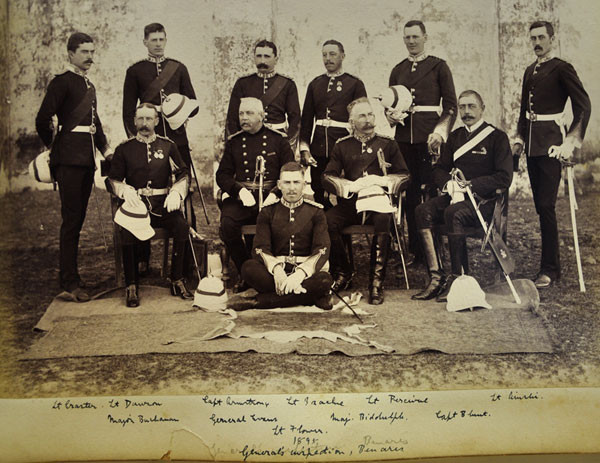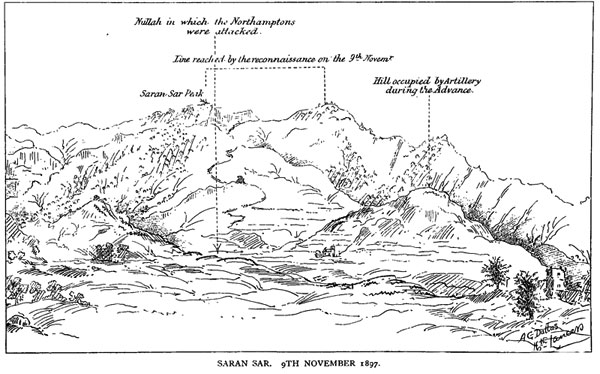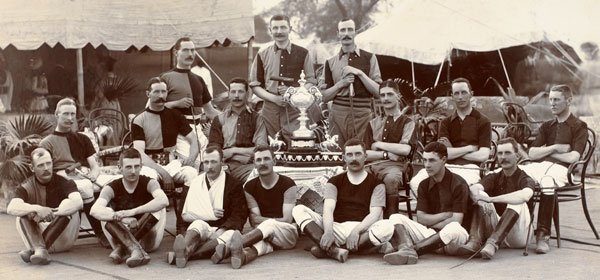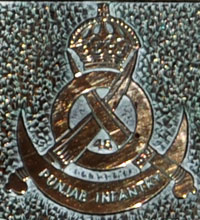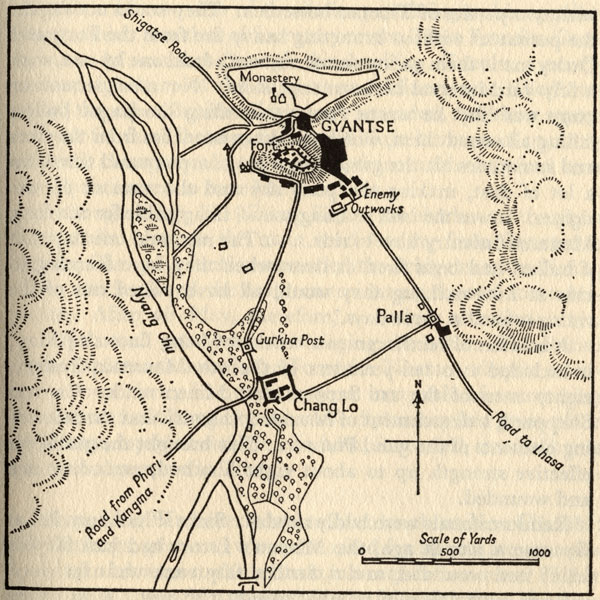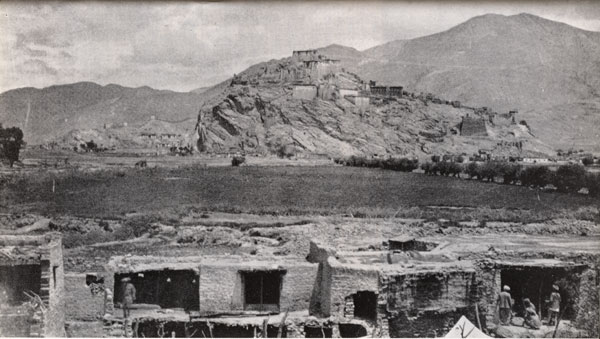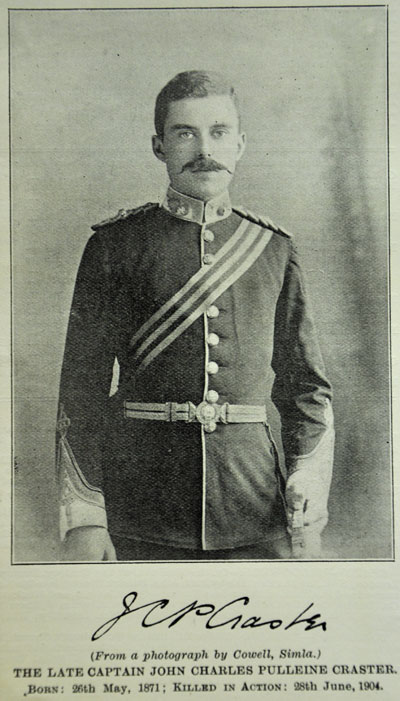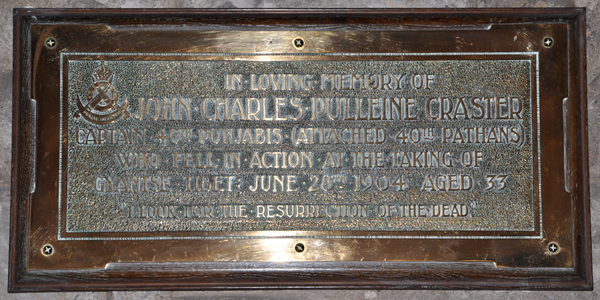 |
|
Archway - Tower Bank |
Memorial to Captain CrasterThe plaque commemorating Captain J.C.P. Craster, who was killed in Tibet on June 28th 1904, is located on the north pier of Craster Harbour, which was built by his family in the years following his death and dedicated to his memory.
JCP Craster was born on May 26th 1871. The 1891 census says he was born in Lesbury, but there is evidence that he was born in Edinburgh and baptised at Holy Trinity in Embleton on July 16th. JCP was the son of John Craster and Charlotte Pulleine Roddam. He was educated at Aysgarth Prep School in Yorkshire and at the United Services College at Westward Ho in Devon. The latter was a public boarding school for the sons of military officers that prepared its pupils for life in the military; one of its more famous students was Rudyard Kipling. Captain Craster is recorded in the 1891 Census as being resident at Craster Tower at which time he was 19yrs old and described as 'A student of the Royal Military Academy Sandhurst.' We can trace Captain Craster's military career through the London Gazette.
The Gazette of January 8th 1892 records his graduation from Sandhurst and enrolment in the Northumberland Fusiliers as a second Lieutenant.
The following entry in the Gazette of November 23rd 1897 indicates that some time after joining the Fusiliers he transferred to the Indian army, gaining promotion to Lieutenant in 1894/5, which was subsequently confirmed by the Queen in 1897.
The Gazette of October 4th 1901 reports Lieutenant Craster's promotion to Captain
Captain Craster served in the Northumberland Fusiliers in the UK for a little over one year before his move to India and transfer to the Indian Staff Corps and then the 40th Pathans. Some episodes in his military life during his service in the Fusiliers are described in the St George's Gazette. At this time the Fifth were based at Dover.
"The ‘Malabar’ was one of five purpose-built troopships paid for by the Government of India and launched in 1866. Although built in different yards, the ‘Malabar’ and her sister-ships, the ‘Crocodile’, ‘Euphrates’, ‘Jumna’ and ‘Serapis’, were all of the same design, tonnage and dimensions. The five vessels were each distinguished by a different coloured riband around the hull, which, in the case of the ‘Malabar’ was black, and all carried the ‘Star of India’ on their bows. Each ship could transport a full battalion of infantry with their families, or about 1,200 people. The ‘Malabar’ initially ran from the Isthmus of Suez in north-eastern Egypt to Bombay but, when the Suez Canal was opened in 1869, she undertook the round trip from Portsmouth to Bombay and back again in 70 days. She remained in service longer than any of her sisters and was only finally withdrawn in 1897 when she became a base ship at Bermuda. Renamed ‘Terror’ in 1901, she was placed on the disposal list in 1914 and sold in 1918." (http://www.nam.ac.uk/exhibitions/permanent-galleries/art-gallery/gallery-highlights/last-troopship) This site features an excellent painting of the ship under sail. The following photograph was taken in 1895 at Benares on the occasion of a General's Inspection. It was in an album compiled by Lieutenant-Colonel A.J.B. Percival D.S.O., now in the Collection of the Northumberland Fusilier Museum at Alnwick Castle. JCP Craster is standing on the left hand side of the group.
To view larger images of this photographs, please follow this link. Captain Craster's obituary from the St George's Gazette (see below) suggests that he participated in the Tirah Expeditionary Force, which took the field in 1897 and 98. The obituary says that Captain Craster participated in the 'affair of November 9th', although it mistakenly dates this action as 1898, not 1897 when it actually took place. This campaign was directed agains the Afridi tribe, who having been paid to protect the Khyber Pass for some sixteen years, revolted in the mid 1890's, capturing all the military posts along the Pass and attacking British military targets along the Samana Range to the south. A substantial force, over 30,000 men under General Sir William Lockhart headed south and east from Peshawar along the Samana Range, before turning north through the Sanpagha and Arhanga Passes and west along the Bara valley back to Peshawar. A second account, by Lionel James, Reuter's Correspondent, can be downloaded here. There is no evidence at this time of Captain Craster being attached to any of the regiments, that participated in the expedition, but it is known from his obituary that in 1895 he was transferred from the Fusilers to the Indian Staff Corps and he may have been a member of Lockhart's staff on this occasion. However he was not reported on the comprehensive list of staff given in an appendix to Lionel James' account of the campaign published in 1898. There was a Craster listed as a member of the expedition; Captain S.L. Craster R.E. This is not to suggest that the obituary is wrong in identifying Captain Craster as a member of the expedition, simply that corroboration has yet to be found. Hutchinson devotes a chapter to this disaster for the British army in India. The 'affair' was a foray from camp beneath the Saran Sar peak, "partly to look up these tribesmen, Zakkakhels all, (the most powerful local clan) and destroy their fortified houses and towers, and partly to have the adjacent country surveyed and mapped." "Brigadier-General Westmacott was nominated to command the expedition, and the following troops placed under his orders for the day :—The Northamptons and the 36th Sikhs, of his own brigade, and the Dorsets and the 15th Sikhs, of the 3rd (Brigadier-General Kempster's) brigade ; also the following Divisional troops:—No. 8 British M.B. R.A., No, 5 Bombay M.B., and No. 4 Company Madras Sappers and Miners. Sir William Lockhart himself rode out with his staff to witness the operations." This action was a success until the forces sought to retire to base camp. During this phase, some of the troops were isolated and almost 20 British soldiers were killed and 29 wounded. "In the meantime a tragedy had been enacted in the centre. A body of Afridis, who had from the slopes above marked the situation, swooped down on the Northamptons entangled in the ravine, and, firing from the high banks on the western side, they shot down the stretcher parties who were nobly engaged in carrying off and protecting their wounded; and though officers and men battled bravely for honour's cause, yet they were not fighting on equal
The number of British casualties and the way that the action is referred to in this shorthand way - 'the affair/action of November 9th' - in the book and the obituary suggests that this was a landmark episode for the army in India at this time. This book concludes with a chapter on tactics, explaining very clearly the use of guerilla tactics by the native combatants. Tactics that must be familiar in Afghanistan today. "The tribesmen's tactics are not dictated by timidity. They do not know what fear means. But they have plenty of common sense, and conscious that they cannot stop us if we really mean to come on, they quietly fall back as we advance, and patiently await their turn, which they know will come as soon as we begin to retire. That instant they assume the offensive. Where only three or four men have been seen before, they now appear in dozens. The rapidity of their movements now is quite extraordinary; and their marksmanship and the skill with which they skirmish from rock to rock, availing themselves of every feature of ground, and constantly threatening to work round the flanks, are marvellous. To retire successfully before such an enemy requires great coolness and judgment. If there is any mistake made, or any sign of hesitation or wavering, it is instantly taken advantage of, and in a moment, where all was going well the minute before, disaster may ensue." "The safety of camps and bivouacs by night is a subject on which a few words may be usefully said. Here, too, the drill-book, admirable as are its maxims, was not of much help to us ; and here, too, the fact that the Afridis now possess long-ranging arms of precision compelled the posting of picquets outside the camp at distances far exceeding anything found necessary in previous expeditions. One great source of annoyance and loss to the troops in Tirah was the firing into camp by night, vulgarly known as " sniping " ; and the only way to stop it was to hold all surrounding commanding points, within a range of 1500 yards to a mile, by strong picquets. Even then, on dark nights, prowling marauders would get in between the picquets and the camp, and make it extremely unpleasant for us while their ammunition lasted ; or until, in their turn, they were stalked and ejected by the Scouts, ...." Captain Craster's regiment, the 46th Punjabis, was raised by Major George Patrick Ranken at Sialkot in October 1900, as the 46th (Punjab) Regiment of Bengal Infantry. It was composed of Punjabi Muslims, Pathans and Sikhs. A photograph album belonging to Ranken, by then a colonel, in the collection of the British Library, contains two photographs of Captain Craster. The following is a group portrait, taken at Sialkot in the north-east Punjab in 1902, of polo teams, posed with cup; JCP Craster is sitting cross legged third from the right on the front row.
To view larger images of this photographs, please follow this link. The other, taken at the same time, features Captain Craster among a group of officers in uniform. (Mss Eur F182/2(2). Captain Craster volunteered for the 1903/04 Tibet campaign, where he was attached to the 40th Pathans. The political mission was led by Sir Francis Younghusband, with the military escort under the command of Brigadier-General J.R.L. Macdonald. It would appear from the following passage, on page 208, in Sir Francis Younghusband's own account of the campaign (in his book "India and Tibet") that the 40th Pathans did not join the military escort until June 1904. If this is the case, then Captain Craster was killed only a short while after becoming involved in the conflict. "Strong reinforcements had now come up from India: the remainder of the mountain battery, under Major Fuller, a wing of the Royal Fusiliers, the 40th Pathans, and the 29th Punjabis ; and on June 13 I set out to return to Gyantse with General Macdonald to relieve the Mission escort at Gyantse and, if need be, to advance to Lhasa, while Colonel Reid remained in charge of the communications." The Gazette of December 13th 1904 included a despatch from General Macdonald regarding the operations of the troops which accompanied the Mission to Tibet. (.pdf) Page 1 Page 2 Page 3 Page 4 Page 5 Page 6 Page 7 Page 8 Page 9 A fuller record of the campaign in which Captain Craster was killed is described in "With Mounted Infantry in Tibet" by Brevet-Major W.J.Ottley, digitised in full by California University (.pdf) (396 pages) Pages 171 - 172 give an account of Captain Craster's death as follows:
"The 40th advanced across the open plain with all the elan of the Pathan, and dashed into the monastery just as the Gurkhas from amongst the rocks opened fire on the Jong at 200 yards range. The ten-pounder common shells had breached the jong splendidly, and the gunners kept up their fire till the Gurkhas were within eighty yards of it, so that the enemy could not stand to their loopholes to fire on the Gurkhas. The co-operation between the guns and infantry was beautiful, and crowned with success. The Tibetans could not stand it, and took to their heels before the Gurkhas got to the Jong; at any rate, few remained to oppose them, and these they soon disposed of. More or less the same took place in the monastery, and most of the enemy bolted over the ridge or hid in the cellars as soon as the 40th gained the lowest houses. One large house at the top held out until the gate was blown in by Captain Shepherd and his sappers. Almost the whole place was in the hands of the 40th when Captain Craster, of that regiment, was shot dead. His day's work was finished, and done well, and it was a sad fatality that claimed him at its close." Sir Francis Younghusband's own account in "India and Tibet" contains the following passage on pages 209 and 210: "On June 26 we reached Gyantse, after encountering considerable opposition at the village and monastery of Niani, which was held by 800 Tibetans. The fight lasted from 10 a.m. till 2 p.m.. Colonel Brander from Gyantse assisting by occupying the hills above the village. Major Lye, 23rd Pioneers, was here severely wounded in the hand and slightly in the head. On its arrival our force was ineffectively bombarded from the jong. General Macdonald had now to break up the Tibetan force investing Gyantse. On the 28th he attacked a strong position on a ridge on which were the Tse-chen monastery and several fortified towers and sangars. The process of clearing the villages in the plain below lasted most of the day. At 5.30 the position itself was stormed by the 8th Gurkhas and the 40th Pathans, supported by the mountain battery. The fight was severe, for the hillside was very steep. Captain Craster, 46th Pathans (sic), was killed whilst gallantly leading his company, and Captains Bliss and Humphreys slightly wounded. The capture of this position much disheartened the Tibetans; communications between Gyantse Jong and Shigatse were cut off, and the jong was now surrounded on three sides." According to General Macdonald's despatch (see above), Captain Craster was the only fatality during this action, with seven 'native rank and file' wounded. The British Forces were based at Chang Lo and made their attack from there. The 'jong' was captured on July 6th; Lieutenant Grant winning the V.C. for his attack across the vertiginous slopes that formed the approach to the 'jong's' walls and through the breach in the walls caused by the 10 pounders. Note: 'jong' castle or fort. 'sangar' trench or dugout protected by piled up stones.
The Daily Mail of July 1st 1904 carried a report of the action in which Captain Craster was killed. "Most of our casualties in yesterday's fight at the taking of the Tsechen Monastery ocurred at close quarters. Captain Craster was the only one shot, being killed by a bullet through the heart when leading his men in a narrow street....Captain Craster was the only man hit among the Pathans which, considering this regiment fought its way up from the plain through the village and the monastery to the top of the ridge, was a most extraordinary circumstance, especially as the enemy maintained a very hot fire and were in superior numbers....Captain Craster's funeral took place this evening, General Macdonald and all our officers being present. The ddeseased officer had seen service on the North West frontier, and was a gallant soldier whose loss is much regretted." Peter Fleming's book, 'Bayonets to Lhasa', first published 1961, is a very readable account of the campaign. ISBN 0 19 583862 9 (Peter was the older brother of Ian Fleming) The following reports of the campaign are items from the Alnwick & County Gazette, published in The Northumbrian magazine, in an article by Phil Huntley. Saturday, June 4, 1904 Saturday July 2nd 1904 "The late Captain Craster. Captain John Charles Pulliene Craster, whose death is recorded, belonged to an old and much respected Northumbrian family, the Crasters of Craster Tower. He was the son of the late Mr John Craster, who was a Justice of the Peace and at one time High Sheriff of the County, and who too had military connections being a captain in the Northumberland Light Infantry Regiment of Militia. Captain. Craster early adopted the army as a profession. Born in 1871, he entered the Northumberland Fusiliers as a second lieutenant in 1892. In 1894 he achieved a full lieutenancy and seven years later a company command. His was a career full of promise and the news of his sad end will be heard with widespread regret. Captain J.C.P. Craster's Obituary, St George’s Gazette July 30th 1904
"The FIFTH have once more to mourn the loss of a comrade Captain J.C.P. Craster - who was killed in the fighting at the village and monastery on the left bank of the River Gyangtse, in Thibet on the 28th of last month. He was not very long in the FIFTH, but, during the short time he was, he earned the love and respect of all ranks of the Regiment; he was appointed second Lieutenant on the 9th of January, 1892, and promoted Lieutenant on the 27th. of October, 1899; had he remained in the FIFTH he would now have been fourth on the list of Captains. The late officer was the, fourth son of the late John Craster, Esq., J.P. and D.L. of Craster Tower, Northumberland, at one time a, High Sheriff of the County; his mother was Charlotte Pulleine, daughter of the late Mr. William Roddam, of Roddam, Northumberland; he was educated at Aysgarth School, Yorks, and Westwood Ho! In 1895 he was transferred from the FIFTH to the Indian Staff Corps, and was promoted Captain in 1901. He took part in the operations on the Samana Range on the North-West Frontier of India in 1898 - 99, and was present at the capture of the Sanpagha and Arhanga Passes, at the reconnaissance of the Saran Sar, and the action of the 9th of November, 1898; he also took part in the operations in the Waran Valley at Divatol and in the Bara Valley; lastly, he volunteered for service with the Thibet Expedition, joining the 40th Pathans at two days' notice. In his death his brother officers, and the Service' generally, have lost a promising young officer. The 5th Fusiliers offer their sympathy to all his family in the loss they have sustained." Captain Craster is commemorated in a Memorial Tablet in Holy Trinity Church, Embleton
IN LOVING MEMORY OF Captain Craster's WillIn the 'Craster Harbour Account Book, 1908 to 1938' we learn that investments were made in the construction of Craster harbour as follows: TW Craster, WR Craster and WS Craster each invested £826-2-6d in the Craster Harbour project. These sums represent more than half of the private funding of the project. A note in the accounts referring to these investments goes on to say: "These sums added together represent 4/5 of the total proceeds of sale of the late Capt. J.C.P. Craster's investments, the remaining 1/5 being paid to the Edmund S. Craster a/c at the Lloyd's Bank, Alnwick." ES Craster did not invest in the project at this time, although he did later, using a bequest he benefitted from upon the death of WR Craster in 1917. This suggests that much of the funding, and perhaps the timing of the harbour's construction, was contingent upon the death of Captain Craster in Tibet. The harbour account book, with annual accounts from 1908 to 1938, which is part of the County Collection at Woodhorn, is an invaluable source of information. Extracts from this book have been transcribed and can be downloaded from here. The spreadsheet was written in Open Office, which can be downloaded free of charge from Open Office. HODIE FELIX CRAS TER - the Craster family motto “Hodie” = today; “Felix” = happy; “Cras” = tomorrow; “Ter = ? It appears that there is a pun on the name here. Ter means 'three times', so perhaps the intended meaning is "Happy today, thrice happy tomorrow." As a biographical footnote, the Younghusband family had roots in Northumberland at nearby Bamburgh. Five of the Younghusband family are listed on a plaque in St Aidan's church, including Major General John William Younghusband, Francis Younghusband's father. Francis himself was born in India and died and was buried in Dorset. |
 |
Home Programme Membership Archive War Memorials History Walk Miscellanea Links Contact Us
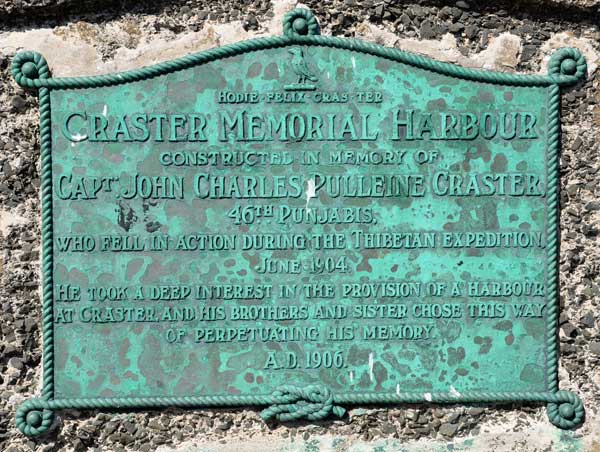
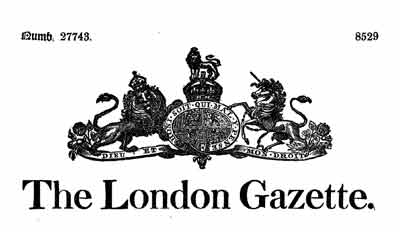
.jpg)
